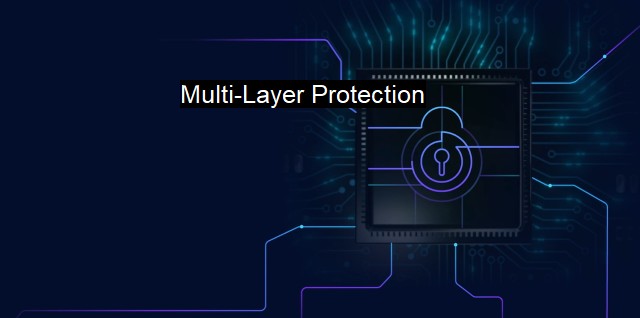What is Multi-Layer Protection?
Multi-layer Protection: Enhancing Cybersecurity with a Comprehensive and Dynamic Approach
Multi-layer protection is a security strategy used in cybersecurity and antivirus programs to guard against potential threats and attacks. This approach combines multiple controls and defenses at various points in a system, designed to block or mitigate malware, phishing attacks, or cyber threats that compromise data or system integrity. multi-layered protection offers multiple layers of defenses to ensure that even if one safeguard fails or an attack surpasses a layer, another mechanism is in play to maintain optimal protection.When compared to the limitations of a single security solution meant to guard against all possible threats, the foreground of multi-layer protection becomes profoundly clear. A solitary layer of cybersecurity defense, such as an antivirus program, isn't strong enough to combat the magnitude of evolving threats the digital world is confronting. The continuous advancements in technology inadvertently lay the ground for an array of sophisticated cyber threat strategies designed by malicious actors, making traditional safety measures obsolete in some instances.
This architecture offers multi-layer protection in a series of sequential and encompassing safety measures. The core of the multi-layer approach is the concept of 'defense in depth'. It involves implementing different strategies across endpoints and networks to ensure comprehensive security. For instance, firewalls guard against external threats, and intrusion detection systems scrutinize irregular patterns in traffic. At the same time, antivirus software provides protection at the system level by identifying and eradicating malicious programs. This defense strategy is continually evolving to address all possible threat vectors systematically and promptly.
Multi-layer protection combines technologies that track identified threats, analyze unidentified or suspicious activity, block intrusions, and facilitate response and recovery mechanisms. If an attacker manages to bypass the firewall, they will face a new security layer, whether it's an end-point anti-malware program, encrypted communication, or a threat detection system, adding more obstacles to prevent the compromise of data.
Another key aspect of multi-layered protection involves keeping the software up-to-date. The ongoing enhancement and fine-tuning of programs help keep up with swiftly evolving cybersecurity threats. Companies releasing newer versions of software or updates often build in patches for the discovered vulnerabilities in their systems, keeping them less susceptible to breaches. Automated updates ensure that all security layers remain regularly updated, reducing the chance for potential exploitation of outdated software.
The implications also bleed into the more rooted human and procedural components of cybersecurity. From dual-factor authentication processes to sturdy management of admin privileges and creating a widespread culture of sturdy password practices, the fight towards robust security is far from contained within solely technological realms.
Considering how an infiltration can occur, it mandates taking a premeditated account of security throughout the system, requiring the acknowledgment that not all controls will resist all intrusions. This calls for an inbuilt incident response strategy in the multi-layered defense, programmed to detect, limit, and neutralize disaster early and effectively.
Though it does not guarantee absolute security, multi-layer protection undoubtedly reduces risk probabilities. Its multi-faceted security apparatus aggregates different types of security technologies working as a unified system to tackle evolving threats aggressively.
In summation, the concept of multi-layer protection embraces a highly holistic approach towards cybersecurity, acknowledging the distinct probabilities of system vulnerabilities and evolving threats—the complexity it enunciates, justifies the essence of defense through depth to carve secure odds for businesses and individuals relying on technology. In this ever-increasing digital landscape of intricacies, clinging to this robust cybersecurity model is more of a necessity than a choice. Hence, nurturing a proactive cybersecurity stance fortified with multi-layered protection is truly synonymous with adapting to the progress of digital intricacies.

Multi-Layer Protection FAQs
What is multi-layer protection in cybersecurity?
Multi-layer protection in cybersecurity refers to the use of multiple security measures to safeguard against different types of cyber threats. It involves implementing a combination of physical, network, and software-based security controls to provide comprehensive protection.Why is multi-layer protection important for antivirus software?
Multi-layer protection is crucial for antivirus software because it helps to ensure that all potential threats are detected and dealt with. By using multiple layers of defense, antivirus software can identify and block malware, viruses, and other malicious software before they can cause any harm to your computer or network.What types of security measures are involved in multi-layer protection?
Multi-layer protection involves a range of security measures, including firewalls, antivirus software, intrusion detection and prevention systems, access controls, and encryption. These measures work together to provide comprehensive protection against various types of cyber threats.How does multi-layer protection improve cybersecurity?
Multi-layer protection improves cybersecurity by providing multiple layers of defense against threats. Rather than relying on a single security measure, multi-layer protection uses a combination of measures to create a more complex and robust security system. This makes it harder for cybercriminals to penetrate your network or steal your data, and increases the chances of detecting and blocking threats before they cause any damage.| | A | | | B | | | C | | | D | | | E | | | F | | | G | | | H | | | I | | | J | | | K | | | L | | | M | |
| | N | | | O | | | P | | | Q | | | R | | | S | | | T | | | U | | | V | | | W | | | X | | | Y | | | Z | |
| | 1 | | | 2 | | | 3 | | | 4 | | | 7 | | | 8 | | |||||||